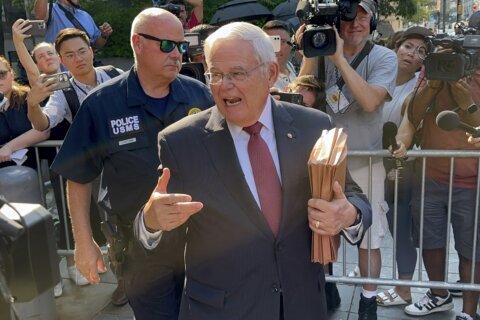HOUSTON (AP) — Sharon Carr is frustrated. Like many others who lost power after Hurricane Beryl slammed into the Texas coast earlier this week, she went to a cooling center in Houston to get relief from summer heat while the city’s utility company warned that restoring everyone’s electricity could take longer than they might hope.
“There’s too much wind, we don’t have power. It’s raining a long time, we don’t have power,” said Carr, who also went without electricity for a week in May when a destructive storm known as a derecho swept through the area.
Carr, who works for the city’s transportation and drainage department, thinks more could be done to keep the lights on — or at least restore them more quickly — if Houston and other urban areas prone to severe weather would stop focusing on immediate problems and look at the bigger picture, including climate change.
“This shouldn’t keep happening,” she said. “If it’s broke, let’s fix it.”
Hurricane Beryl is the latest in a long line of devastating storms to paralyze Houston, underscoring the city’s inability to sufficiently fortify itself against weather events brought on by climate change. Past storms such as Hurricane Ike in 2008 and Harvey in 2017 made clear that the city needed to remove trees, bolster its flood-plain protections and bury more power lines underground, but those efforts fell short or were completely overwhelmed by recent storms that have inundated the city and knocked out power to millions.
With climate change heating up ocean water, fueling storms that are more powerful and intensify much faster, experts say cities need to rethink how they prepare and respond to such events.
“It’s a totally different game that we’re playing today,” said Michelle Meyer, director of the Hazard Reduction & Recovery Center at Texas A&M University. The old playbook, she said, “doesn’t work anymore.”
If we rebuild it, it will flood again
Where and how developers build is one obvious issue, said Craig Fugate, administrator of the Federal Emergency Management Agency under President Barack Obama. He said that became evident to him 20 years ago while working in Florida, where four successive hurricanes were not enough to stop beachfront development.
“You’ve got to ask yourself, how many times do we need to rebuild something before we either build it back differently or we don’t build back in that same spot?” he said.
Fugate thinks taxpayers are increasingly shouldering the burden, supporting expensive insurance programs for at-risk areas when instead, developers could stop building in storm-prone areas and residents could move out of the floodplains.
“It is the hardest system to implement because people resist,” said Jim Blackburn, co-director of the severe storm center at Rice University. “People really like where they live, as a general proposition.”
Buyouts instead of insurance payments are one way to get people to move, but Fugate notes such programs often take too long to kick in after a storm hits. By the time such funds are ready, persuading someone to take a buyout is “almost impossible,” he said.
Problems with known solutions
In many cases, officials know what actions are needed to mitigate severe weather disasters, but find them hard to implement.
For instance, the city of Houston commissioned a report documenting how falling trees caused power outages after 2008’s Hurricane Ike. But no one wanted to cut down the trees that still stood. Today, utility officials note, they install underground electric lines for every new construction project.
Updating the city’s electrical infrastructure could also go a long way toward preventing power outages, Meyer said, noting that North Carolina did so after Hurricane Matthew in 2016.
“They were really forward-thinking, like, ‘OK we’re not going to be in this situation again,’” she said.
CenterPoint Energy, which provides Houston’s power, has partially installed an “intelligent grid” system that automatically reroutes power to unaffected lines during an outage. A document on the utility’s website noted that 996 of the devices had been installed as of 2019 — less than half of the grid at the time. It’s not clear if more progress has been made since then. The company did not respond to requests for comment Wednesday.
A changing reality
With more storms like Beryl expected under climate change conditions, cities have to plan for the worst — and the worst is getting nastier.
“It’s all about learning to live with water,” Blackburn said.
After Hurricane Harvey — the fiercest hurricane to hit the U.S. in more than a decade when it slammed into the Texas coast in August 2017 — Houston passed a $2.5 billion bond measure to finance flood damage reduction projects in Harris County, which includes the city. The action resulted in “a lot of improvements,” Blackburn said, but was based on old flood projections.
In addition, a task force Republican Gov. Greg Abbott created in 2018 made dozens of recommendations in a nearly 200-page report, including investigating ways to harden utilities and creating an inventory of mitigation and resiliency projects that are needed across the state.
But with weather becoming more and more unpredictable, even cities that make improvements can be caught unprepared if they don’t plan with the future in mind. The “diabolical” component of climate change, Blackburn said, is that the goalposts keep moving: Just as cities adjust to a heightened risk, the risk escalates again.
Scientists are more equipped than ever before to make decisions about evacuations, development and other measures using computer systems that can predict the damage a certain storm will inflict, noted Shane Hubbard, a research scientist at the University of Wisconsin.
And yet, he added, all the computing power in the world can’t match the unpredictability of climate change. Warming oceans are driving rapidly intensifying weather events that defy models and quickly change conditions on the ground.
“That’s the thing I’m most concerned about” in the future, Hubbard said.
Complicating matters in Texas is that some leaders still don’t acknowledge climate change. The report issued by the governor’s task force in 2018 noted that powerful natural disasters in Texas would become more frequent because of a changing climate. But it made no mention of “climate change,” “global warming” or of curbing greenhouse gases in Texas, the nation’s oil-refining epicenter that leads the U.S. in carbon emissions. Texas is a state where politicians, at least publicly, are deeply skeptical about climate change.
Cities must be willing to face the scientific facts before their planning can truly improve, Blackburn says.
Asked whether coastal cities in general are prepared for climate change, Meyer said simply, “No.”
She said prevention and mitigation measures must evolve to the point that a Category 1 hurricane “will be no problem moving forward.”
A city like Houston “should not be touched by a Cat 1,” she said.
___
Walling reported from Chicago. Associated Press/Report for America writer Nadia Lathan in Austin, Texas, contributed to this report. Follow Walling on X: @MelinaWalling.
___
The Associated Press’ climate and environmental coverage receives financial support from multiple private foundations. AP is solely responsible for all content. Find AP’s standards for working with philanthropies, a list of supporters and funded coverage areas at AP.org.
Copyright © 2024 The Associated Press. All rights reserved. This material may not be published, broadcast, written or redistributed.







